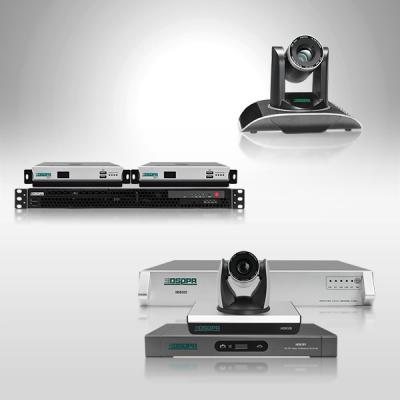

Chat now

Nowadays, more and more companies use video conferencing. For some software video conferencing, ordinary PCs can also be used for video conferencing. Then, can ordinary PCs replace video conferencing terminals? The answer is yes, but compared with professional video conference terminals, ordinary PCs and hardware terminals still have certain differences, mainly in the following points:
1. Different CODEC equipment
The core of the professional video conference terminal is to encode, compress, and process the analog video and audio collected by the camera. This is because the analog video and audio signal is too large to be directly transmitted over the network, and the image and sound quality without pre- and post-processing will also be relatively poor. The more excellent the compression algorithm, the better the image and sound pre-processing algorithm, the greater the amount of calculation, the greater the resource overhead. This resource refers to the computer's computing speed, parallel processing capacity, bus throughput capacity, etc.
The software video system runs on an ordinary PC, and its encoding and decoding operations are completed by a general-purpose CPU. Because the general-purpose CPU is a serial processing structure (only one task can be processed at a certain time), it also needs to serve the operating system (WINDOWS) and many other programs. So, it is difficult to achieve high-quality video and audio processing requirements.
2. Video capture equipment is different
The PC itself does not have the video capture function. When a PC is used as a video conference terminal, external equipment is required. Some use USB capture cards, and some use PCI capture cards. The performance and quality of these capture devices purchased on the market are difficult to guarantee, as the image outline is not clear, not smooth, and the chroma is not full.
The professional video conference terminal adopts independent video pre-processing and professional video capture chips to collect and transform the stream pure, which can ensure a fresh and natural image.
3. Audio capture and processing are different
The audio collection of the PC relies on the ordinary sound card in the host. This amateur-level sound card collects and transforms the audio data with low fidelity and high additional noise. It can be barely used with headphones, but it is used in conference rooms for multi-person meetings. At the time, it is unable to solve the echo problem caused by high-power audio output and sensitive audio pickup.
Professional audio processing chips are used in professional video conference terminals to form a sound collection and output system. The complete audio system includes automatic gain control, automatic level control, noise reduction processing, echo cancellation, audio error correction, and low-frequency compensation. The sound can be emitted from the speaker to ensure the quality of the multi-person group meeting in the conference room.
4. The video output mode is different
Ordinary PCs generally do not have a TV output interface. If you want to output images to a TV, you need to connect an external VGA to a TV device. This conversion is difficult to meet professional requirements, and the video image is not clearly visible on the TV.
The professional video conference terminal uses a special chip for composite video processing and output, making the video image clearer on the TV.
5. The ease of use of the system is different
The software's video system uses the keyboard and mouse on the PC to operate.
The professional video conference terminal uses a dedicated wireless keyboard and remote control, and the operation and control of the general meeting can be completed by using the remote control handle. It is simple and quick to use, and even those who do not understand the use of computers can control the meeting smoothly.
6. The security and stability of the system are different
Ordinary PCs are of general level from chip to board. The stability of the hardware itself is average, and the desktop WINDOWS operating system is used. Such a general operating system is not only poor in security and vulnerable to viruses, but it will generally run for a period of time. A lot of "garbage" is produced, which reduces the operating efficiency of the system and often requires routine maintenance.
Professional video conference terminals are dedicated to the chip level, and after the strict screening, the hardware platform itself is highly stable. Moreover, using an embedded operating system, the system is short and capable and is not vulnerable to virus intrusion and attack. The stability and efficiency of the system are relatively high, and routine maintenance is not required.
 【DSPPA Demo】PAVA8000 EN54 Voice Evacuation SystemNovember 12, 2020Abstract: DSPPA PAVA8000 EN54 Voice Evacuation SystemToday, we are gonna show you a demo about our PAVA8000 EN54 Voice Evacuation System.PAVA8000EN54 Voice Evacuation System can not only support manua...view
【DSPPA Demo】PAVA8000 EN54 Voice Evacuation SystemNovember 12, 2020Abstract: DSPPA PAVA8000 EN54 Voice Evacuation SystemToday, we are gonna show you a demo about our PAVA8000 EN54 Voice Evacuation System.PAVA8000EN54 Voice Evacuation System can not only support manua...view The National Standard Approval Meeting held in BeijingJuly 19, 2019The National Standard Approval Meeting held in BeijingThe approval meeting of the National StandardTechnical standard of public address system engineeringis held in Beijing on July 16, 2019. Xue Chang...view
The National Standard Approval Meeting held in BeijingJuly 19, 2019The National Standard Approval Meeting held in BeijingThe approval meeting of the National StandardTechnical standard of public address system engineeringis held in Beijing on July 16, 2019. Xue Chang...view